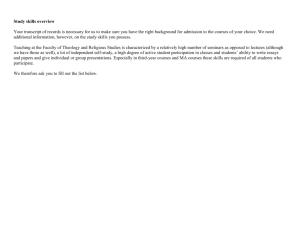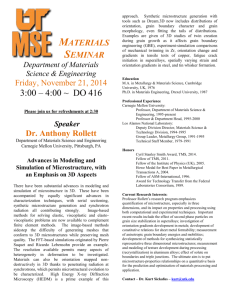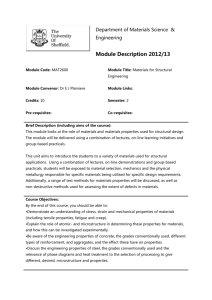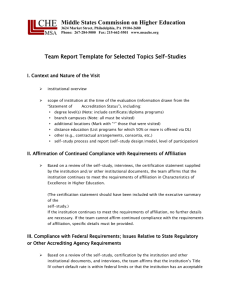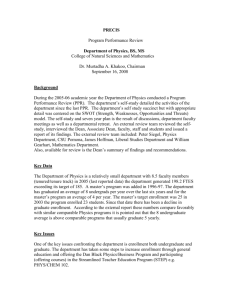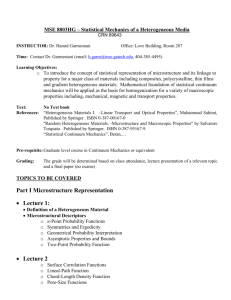model.
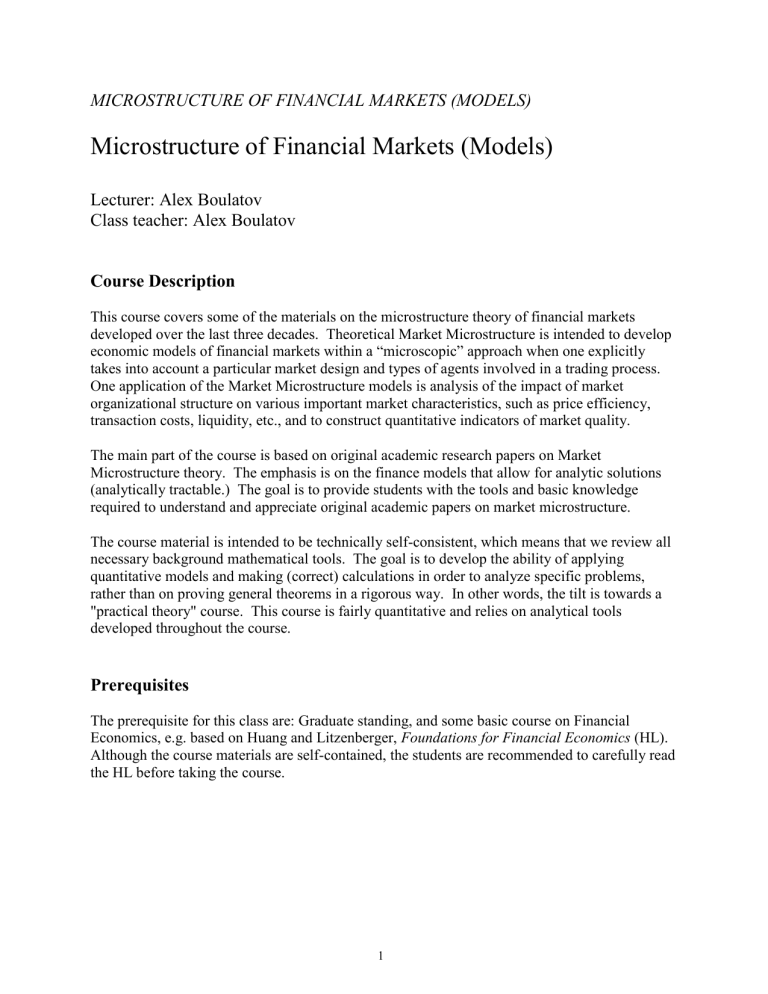
MICROSTRUCTURE OF FINANCIAL MARKETS (MODELS)
Microstructure of Financial Markets (Models)
Lecturer: Alex Boulatov
Class teacher: Alex Boulatov
Course Description
This course covers some of the materials on the microstructure theory of financial markets developed over the last three decades. Theoretical Market Microstructure is intended to develop economic models of financial markets within a “microscopic” approach when one explicitly takes into account a particular market design and types of agents involved in a trading process.
One application of the Market Microstructure models is analysis of the impact of market organizational structure on various important market characteristics, such as price efficiency, transaction costs, liquidity, etc., and to construct quantitative indicators of market quality.
The main part of the course is based on original academic research papers on Market
Microstructure theory. The emphasis is on the finance models that allow for analytic solutions
(analytically tractable.) The goal is to provide students with the tools and basic knowledge required to understand and appreciate original academic papers on market microstructure.
The course material is intended to be technically self-consistent, which means that we review all necessary background mathematical tools. The goal is to develop the ability of applying quantitative models and making (correct) calculations in order to analyze specific problems, rather than on proving general theorems in a rigorous way. In other words, the tilt is towards a
"practical theory" course. This course is fairly quantitative and relies on analytical tools developed throughout the course.
Prerequisites
The prerequisite for this class are: Graduate standing, and some basic course on Financial
Economics, e.g. based on Huang and Litzenberger, Foundations for Financial Economics (HL).
Although the course materials are self-contained, the students are recommended to carefully read the HL before taking the course.
1
Teaching methods
The following methods and forms of study are used in the course:
• Lectures.
• Paper presentations: students are expected to present and discuss in class some required original papers specified by the instructor. Active participation is required.
• Self-study: preparing for classes, it is important to read the corresponding required original research papers and chapters in the textbooks as indicated in the course outline below.
Course Material
The lecture notes and required original papers contain all required material. The readings of journal papers will be announced in class. In addition, the recommended texts are:
(DJR) De Jong, F., and B. Rindi, 2010, The Microstructure of Financial Markets ,
Cambridge Univ. Press, Cambridge.
(LH) Harris, L., 2003, Trading and Exchange , Oxford Univ. Press.
Also recommended for this course are the following supplement references
(MO) O’Hara, M., 1995, Market Microstructure Theory , Oxford, Blackwell.
(RL) Lyons, R. 2001, The Microstructure Approach to Exchange Rates , Cambridge, Mass:
MIT Press.
Grading, Exams, and Homework
•
Class participation including the presentation of papers accounts for 20%.
•
The midterm exam accounts for 20%.
• The rest of the grade (60%) comes from the final exam.
•
The exact material covered in each of the two exams will be announced in class.
The Advanced Topics in Finance consists of three parts. The final grade is computed as an average of the grades obtained in each part of the course.
Analytic and technical skills
This course is rather demanding in terms of the analytic skills. Although the course materials are self-contained, you are encouraged to “brush up” your basic knowledge in several areas, including basic analysis, random processes, and linear algebra. Moreover, it is important to have a “hands on” understanding of all required mathematical concepts. This can be achieved by solving specific problems and analyzing the solutions.
2
C
ourse Outline
I Introduction
Institutions and market structure.
Lecture notes. DJR, Chapter 1. LH, Chapter 1.
II Information and prices; Rational Expectations Equilibrium (REE)
II.1
Hellwig (1980) model.
Lecture notes. Hellwig, 1980, Journal of Economic Theory .
II.2
Grossman-Stieglitz (1980) model.
Lecture notes. DJR, Chapter 2.
Grossman, S. and J. Stieglitz, 1980, American Economic Review .
III Models of strategic trading
III.1
Auction markets.
Lecture notes. DJR, Chapter 3.
Kyle, A., 1985, Econometrica . Classical paper; both single and multiperiod settings.
Single asset case.
Admati, A., 1985, Econometrica . Extension to single period case with multiple assets –
3
self-study and presentations.
Admati and Pfleiderer, 1988, Review of Financial Studies . Strategic trading and intraday patterns. Discretionary liquidity traders – self-study and presentations
III.2
Dynamic strategies.
Lecture notes.
Kyle, A., 1985, Econometrica .
Back, K., H. Cao, and J. Willard, 2000, Journal of Finance . – self-study and presentation.
IV Information and markets
Lecture notes.
Admati, A., and P. Pfleiderer, 1988,
Admati, A., and P. Pfleiderer, 1990,
Cespa, J., 2005, Working paper
Hirshleifer, J., 1971,
.
American Economic Review
Econometrica –
American Economic Review
. self-study and presentations.
, -- Self-study and presentation.
Point: informed equilibrium could be less efficient than the uninformed one , at least for some groups of agents.
V Liquidity and algorithmic trading
V.1 Optimal execution
Lecture notes.
Almgren, R., and N. Chriss, 2000,
V.2 Market quality issues
Journal of Risk .
Lecture notes. DJR, Chapter 10.
Brunnermeier, M., and L. H. Pedersen, 2005, Journal of Finance – self study and presentations.
Hendershott, T., C. M. Jones, and A. J. Menkveld, 2009, Journal of Finance . – Self-study
4
and presentation.
Kirilenko, A., A. Kyle, M. Samadi, T. Tuzun, 2010, Working paper – Empirical analysis of role of different types of traders in the “Flash crash” (2009). Conclusion: informed speculators might have made a negative impact. Self-study, presentations and discussion.
VI Models of the limit order book (LOB)
Lecture notes. DJR, Chapter 8.
VI.1 Uninformed liquidity providers
Glosten, L., 1994, Journal of Finance .
Obizhaeva, A., and J. Wang, 2005, Working paper . Self-study and presentation.
Point: simple model of the LOB allows to incorporate dynamic price impact. This is relevant to optimal execution problems.
VI.2
Informed liquidity providers
Kyle, A.,1989, Review of Economic Studies . Pioneering paper; similar to Kyle (1985) it sets up a framework for many subsequent extensions. In this case: uninformed liquidity demanders.
Boulatov, A., and T. J. George, 2012, Review of Financial Studies, forthcoming.
Setting: Both liquidity providers and demanders are informed. Endogenous choice of types within a single-period model setting. Non-discriminatory pricing rule.
VII Microstructure models: overview.
5
Distribution of hours
#Topic
Introduction
Information and Prices; REE 4
Models of strategic trading
1. Auction Markets
2. Dynamic strategies
14
6
Total hours Contact hours Self-study
8 4 4
2 2
6
2
8
4
Information and markets
Liquidity & algorithmic trading
6
1. Optimal execution
2. Market quality issues
Models of limit order book
6
10
8
2
2
2
2
4
4
8
6
Total: 62 22 40
6

